DoT Tightens Noose on Unused Transmitters, Issues Post Licence Disposal Playbook

India’s airwaves are tightly policed, but until this month no one had told licence-holders what to do with the physical boxes once the permission expires. On 15 October 2025 the ministry of communication, department of telecommunications ended the ambiguity, issuing a guideline that starts its stop-watch the very day a Wireless Operating Licence experimental, demonstration or plain WOL expires for any reason. The order, signed by Assistant Wireless Adviser, is short, stern and backed by the threat of “wilful-violation” prosecutions under the Indian Telegraphy Act.
The guidelines open by a reference to an earlier office memorandum of 27 July 2023 had hinted that equipment accountability would be tightened, but left the “how” to imagination. The new text fills every gap. It applies to every entity, private or public, that possesses radiating hardware under licences issued by WPC headquarters, any Regional Licensing Office or the Wireless Monitoring Organisation. There is no phased roll-out; the clock starts on the date of issue itself and will stay in force until the yet-to-be-notified Frequency Assignment Rules under the Telecommunications Act 2023 arrive.
A licence can expire in four ways, and the memorandum writes a separate script for each. When the licensee itself seeks cancellation, it is given the longest rope ie., ninety days either to scrap, return or transfer the apparatus, or else to obtain a fresh Non-Destructive Possession Licence (NDPL) from the local WMO field unit. The moment the request is uploaded on the portal a deemed NDPL springs to life, but only for those ninety days; miss the deadline and the same equipment becomes contraband.
A quieter expiry simple failure to renew triggers a shorter timetable. The portal will generate an automated notice on expiry day, giving the holder just thirty days to dispose of every transmitter, receiver or transceiver and to upload a disposal certificate within seven days of finishing the job. During that month the gear enjoys deemed NDPL cover; stretch it beyond and the violation flag is raised.
Government-induced termination is the most abrupt expiry. If DoT cancels a licence for breach of conditions, the operator has only fifteen days to rid itself of the hardware and submit a surrender certificate. Here even the deemed NDPL is a bare fifteen-day shield, emphasising that the State views breach-driven shutdowns as a matter of spectrum security.
Retaining the kit for a future experiment is still possible, but only if the user anticipates the expiry and secures a regular NDPL before the old licence lapses. There is no deemed grace for long-term storage; possession without the fresh paper is treated as unlicensed from day one.
The memorandum then lists the five manners in which “disposal” can be proven. The friendliest is to ship the equipment back to the original vendor or to any WPC-authorised dealer. A second licence held by the same entity or by a third party with identical frequency clearance can also absorb the hardware, provided the transfer is logged. If no market exists, the apparatus must be destroyed in front of a WMO inspector or a licensed dealer so that it can neither transmit nor receive; government labs may self-certify the demolition but must still intimate WPC within ten days. Whichever route is chosen, the final paragraph of the order reminds users that circuit boards, batteries and metal carcasses are now telecom-specific e-waste under the Environment Ministry’s 2022 rules and must reach only authorised recyclers.
Failure is expensive. Each clause repeats the same two-line warning: non-compliance will be deemed wilful, inviting “appropriate action” by DoT words that open the door to fines, black-listing and even criminal prosecution under the wireless statutes. With spectrum auctions growing dear and security agencies ever watchful of stray signals, WPC has effectively shifted life-cycle liability for every radio chip onto the licence-holder.
The message is unmistakable. An experimental frequency is not a sandbox where hardware can be forgotten once the test is over; it is a temporary lease on public property, and the moment the lease expires the gear must be gone within ninety, thirty or fifteen days, depending on how the licence met its end. Laboratories, start-ups, campus radio clubs and public sector giants must now calendar their licence tenures as closely as they track their grants, because the countdown to disposal has been hard-wired into the licence itself.
For further details write to contact@indialaw.in
By entering the email address you agree to our Privacy Policy.



